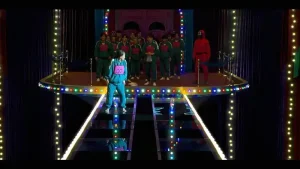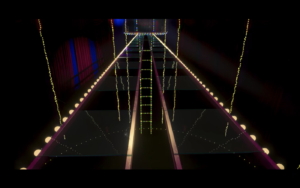With the popular dystopian Korean drama, Squid Game, taking over nearly every corner of the internet, the penultimate ‘Glass Stepping Stones’ round featured in episode 7 has spiked interest in ‘tempered glass’ on Google by 200%!¹

Image credit: Netflix
Should you ever find yourself in a real-life Squid Game, we’ve shared our expertise to help you identify the difference between regular and tempered glass.
What is tempered glass?
Tempered glass (also known as toughened or strengthened) is much stronger than ordinary or annealed glass. When tempered glass breaks, it forms into small and less harmless pieces, unlike annealed glass, which can shatter into large, sharp shards when broken.
You will often find tempered glass used in environments where safety is an issue, including glass balustrades, shop windows, entrance doors, shower and tub enclosures, and staircases.
How is tempered glass manufactured?
Tempered glass is created via a thermal tempering process where the glass is placed in a furnace, heated and then cooled rapidly to introduce stress into the surface of structural glass, strengthening it for enhanced safety.
Tempered glass can then be laminated to improve its strength and durability. At Specialist Glass Products, we use various specialist interlayers, including Kuraray’s Sentry Glass which we laminate between two layers of tempered glass. This enhances the performance of the glass as the interlayer offers five times the tear strength and 100 times the rigidity of the more conventional PVB interlayer.
How can you tell the difference between tempered glass and annealed glass?
Within the famous Squid Game episode, one of the final characters reveals that they were a glass manufacturer for 30 years and can tell the difference between the tempered and ordinary glass panels, saying, “If you look at the tempered glass from an angle under the light, you can see faint stain marks.”

Image credit: Netflix
Our managing director, Andrew, reveals, “I’m not aware of any stains in tempered glass unless it hasn’t been cleaned properly! However, in certain polarised lighting, you may find Anisotropy, a leopard spot like effect you may have seen on a car window when wearing sunglasses.”
“Most tempered glass will have a slight surface variation due to the additional manufacturing processes to strengthen it. This effect is called Anisotropy, caused by the introduction of stress and tension to the glass. Although it may be tricky to see in natural light, these stains are noticeable under bright and polarised light.”
Other than the appearance of light through the glass, the panel surfaces would also be a useful indicator of whether it would be safe to jump on or not. Andrew commented, “Non-tempered glass is always perfectly flat, sometimes with tempered glass you may get slight roller wave which would show in certain lighting at certain angles.”
Another tactic seen within the show is the use of sound to tell the difference. One of the remaining contestants uses a marble to throw at the panel, stating, “Another hint is the sound. Tempered glass is made at high temperatures, above 700 degrees. If you tap it with a hammer, it rings clearer than normal glass.”
Although this theory seems plausible, Andrew advised this is not something he is aware of, adding, “tapping glass you’re standing on with a hammer to see if its tempered is probably not advisable.”
How can we help you?
We wouldn’t recommend recreating your own Squid Games, but we insist on implementing glass flooring to enhance natural light within your next project, creating a more bright and airy environment.
All of our flat toughened glass is manufactured in our custom-built factory to EN 12150 standards, plus we can offer a full range of thicknesses using our state of the art CNC processing machine.
Contact our team today to find out more about our products and services.
Sources
- Google Trends data for search term ‘tempered glass’ – data correct as of 15th October 2021.



